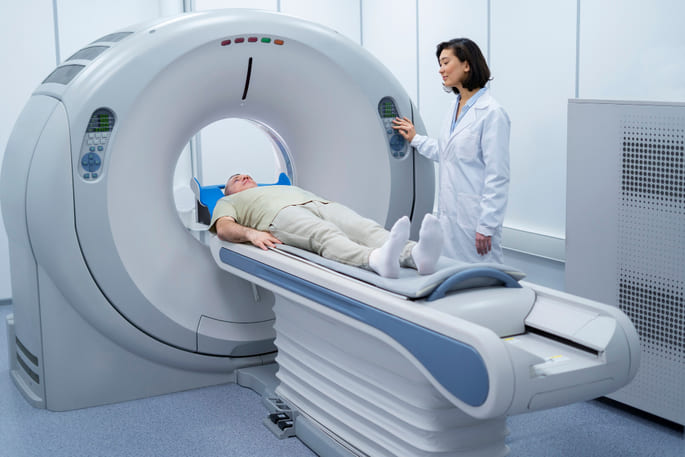This Is The Reason Why Are CT Scans So Expensive
CT scans, or computed tomography scans, have become essential diagnostic tools in modern medicine, allowing healthcare providers to assess a range of conditions from fractures to cancers with exceptional clarity. However, the price of these scans often raises eyebrows. Have you ever wondered why a single CT scan could cost several hundred to thousands of dollars? Let’s explore the factors that drive up the cost of these crucial medical procedures.
1. State-of-the-Art Technology
A significant contributor to the high price of CT scans is the advanced technology involved. Unlike traditional X-rays, CT scans use sophisticated X-ray beams and computerized technology to produce detailed cross-sectional images of the body. The machines themselves are intricate and expensive to develop and maintain, with some models costing millions of dollars.
The CT scanner works by rotating X-ray beams around the body, capturing data that’s sent to a computer. This data is then processed to generate precise, high-quality images of internal structures, including bones and soft tissues. Hospitals and imaging centers must invest heavily in these machines and ensure they are regularly maintained and calibrated for optimal performance, which adds significantly to the overall cost.
2. Operational Expenses
The expense of operating a CT scanner goes beyond the purchase of the machine itself. Several ongoing costs are associated with its use:
- Energy Use: CT scanners consume large amounts of electricity, particularly during high-resolution scans.
- Maintenance: Frequent maintenance and calibration are essential to keep the machine working efficiently. Replacing parts, troubleshooting errors, and ensuring image accuracy require skilled technicians, all of which add to the expense.
- Personnel: Operating the CT scanner requires skilled professionals, including radiologic technologists who perform the scan and radiologists who interpret the images. Their wages, along with administrative staff salaries, contribute to the overall cost of the service.
3. Specialized Expertise
After the scan is completed, the resulting images must be carefully analyzed by a radiologist, a specialist trained in interpreting diagnostic imaging. The process of reviewing the images and compiling a detailed report can be time-consuming, especially when the case is complex. The expertise of these specialists is another cost that gets factored into the final price.
In many cases, the radiologist must also collaborate with other healthcare professionals to determine the best course of action based on the CT scan results, further raising the cost of care.
4. Insurance and Billing Complexity
Even though most people have health insurance, CT scans can still be quite costly due to complicated billing practices. Depending on your insurance plan and coverage details, a CT scan may not be fully reimbursed. Co-pays, deductibles, and out-of-pocket payments can pile up for patients, making the procedure even more expensive.
Moreover, hospitals and imaging centers must deal with a complex web of administrative tasks, such as insurance verification, coding for procedures, and handling reimbursements. This administrative workload adds to the cost of providing the scan, which can ultimately be passed on to the patient.
5. Location and Facility Type
The cost of a CT scan can vary based on geographic location and the type of facility providing the scan. In urban areas where the demand for healthcare is high, prices are often inflated due to increased operating expenses like real estate, utility costs, and higher salaries for healthcare workers. On the other hand, smaller or rural areas may offer lower-priced scans, although access to state-of-the-art equipment might be more limited.
Additionally, hospitals typically charge more for CT scans than outpatient clinics or specialized imaging centers. Hospitals have much higher overhead costs due to the wide array of services they provide, including emergency care and inpatient treatment. Imaging centers, which focus solely on diagnostic procedures, can often provide CT scans at a lower cost.
6. Liability and Overuse Concerns
CT scans involve exposure to radiation, which, although controlled, presents a certain level of risk. As a result, healthcare providers must ensure that these scans are only ordered when necessary. Misuse or overuse of CT scans can lead to unnecessary costs and potential harm, both financially and medically.
Furthermore, healthcare professionals must also consider the potential liability risks that come with medical procedures. Errors in interpreting results or performing the scan could result in legal consequences. This potential for liability contributes to the higher cost of CT services.
7. Market Demand and Supply
As with many services, the cost of a CT scan can be influenced by supply and demand. In areas where access to CT machines is limited, or where only a few providers offer the service, the cost can be higher due to reduced competition. In contrast, in locations with multiple facilities offering CT scans, the price may be more competitive.
8. Regulatory and Safety Standards
CT scans are subject to strict regulatory oversight to ensure both safety and accuracy. The machines must adhere to rigorous safety protocols, and imaging centers must follow strict procedures to minimize radiation exposure. Compliance with these standards requires investment in training, certification, and quality control, all of which add to the cost of the procedure.
9. Challenges with Insurance Reimbursement
Another factor contributing to the high price of CT scans is the often challenging process of insurance reimbursement. In many healthcare systems, particularly in the United States, insurance companies may only reimburse a fraction of the total cost or may delay payments, creating financial shortfalls for medical providers. To compensate for these potential gaps, hospitals and imaging centers may increase the price of the scans to ensure they cover their operational costs.
